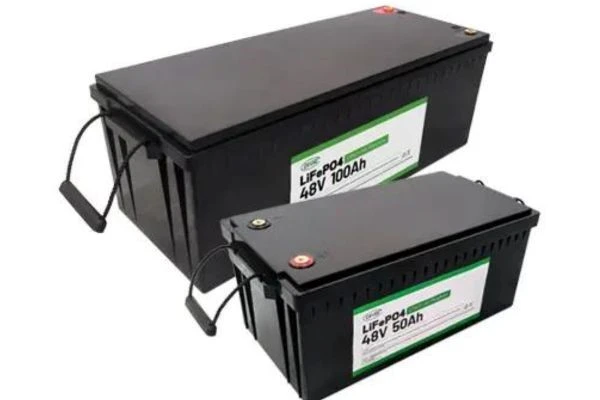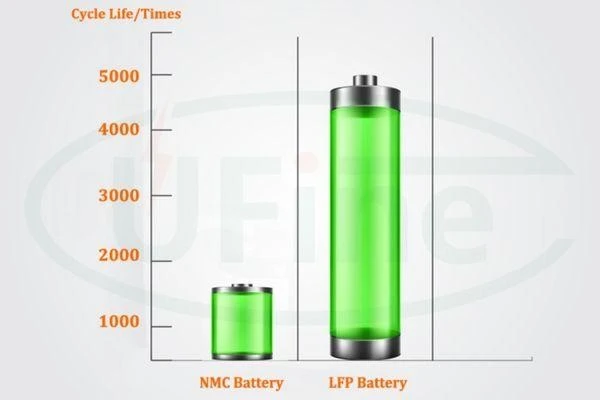LiFePO4 battery is known as Lithium Iron Phosphate, the most advanced technology with high energy density and a long battery cycle. LiFePO4 battery life is 5x higher than a regular lithium battery. However, it is important to understand that LiFePO4’s lifespan is not fixed. Like many other batteries, LiFePO4’s battery life can depend on proper usage, maintenance, and care. This article will discuss the factors and ways to extend LiFePO4 battery life.
Part 1. Overview of LiFePo4 battery life
LiFePO4 battery works on three primary elements: Lithium, Iron, and Phosphates. It utilizes Ions that are being charged and discharged. Here is the breakdown of why LiFePO4 battery life is longer than traditional lead acid and lithium batteries.
1. Stable Crystal Structure
The most defining element of the battery is its stable crystal structure. The cathode structure of LiFePO4 is strong and less prone to breakdown during the charging and discharging process. Therefore, it leads to slow degradation to achieve maximum LiFePO4 battery life.
2. Reduced Stress
LiFePO4 battery utilizes lithium ions in a fixed method during the charging and discharging process, causing less stress on the battery. The crystal structure helps lithium ions move smoothly in and out of the cathode, reducing strain on the material. As a result, LiFePo4’s lifespan has significantly increased.
3. High Tolerance for Depth of Discharge (DOD)
Lithium Iron phosphate can handle deep discharge situations. The battery can tolerate depth of discharge (DOD) very well compared to others that degrade with time. On the contrary, LiFePO4 battery life has a very minimal effect on deep discharge.
4. Thermal Stability
Many advancements are being made in thermal stability to increase LiFePo4 battery cycle life. It doesn’t generate unstable chemical intermediates that can contribute to heat generation and potential safety hazards.
Part 2. Factors affecting LiFePo4 battery life
1. Charging Rate
If the battery does not charge properly, it can affect the LiFePO4 battery life. Each battery has its charging criteria. Therefore, charging the battery with a lower voltage or higher voltage than recommended can cause a reduction in LiFePO4 lifespan.
2. Depth of Discharge (DOD)
Although the LiFePO4 battery can handle Depth of Discharge (DOD), it can also cause a minor impact on the LiFePO4 battery cycle life.
3. Temperature
Extreme hot and cold temperatures can be detrimental to LiFePo4 batteries. Heat accelerates degradation, while cold temperatures can reduce capacity (although this effect is usually temporary). Operate the battery within its recommended temperature range for optimal performance and lifespan.
4. Storage
Another factor that can affect LiFePO4 battery life is if you leave the battery discharge for a longer period. The LiFePo4 lifespan can be affected if the storing conditions are wet, moisturized, or heated.
5. Number of Cycles
Lithium iron phosphate LiFePO4 battery has more than 4000 life cycles. However, the number of cycles is flexible as it depends on the conditions. Therefore, the battery cycle will decrease the power storage capacity over time.
6. Cell Balancing
If you have a battery with multiple cells, it can imbalance the battery during the charging and discharging process. So, you should take care of cell balancing to get higher LiFePO4 battery life.
7. Manufacturing Quality
The quality of materials and manufacturing processes used to create the battery can also impact LiFePO4’s lifespan. Reputable manufacturers are known for using high-quality components.
Part 3. How to extend LiFePo4 battery life
You have now understood that the Lifepo4 battery life relies on several factors. You must keep all the aspects up to the mark to gain a good LiFePO4 lifespan. To better understand this, we have explained the two ways to extend LiFePo4 battery life. One is about battery manufacturing, and the other is about usability.
1. Battery Manufacturing Aspects
The decision to choose a LiFePO4 battery is very important. Choose a well-reputed battery manufacturer with good battery material and rating. Using their battery will provide mental peace and quality service in the coming years.
2. Cell Selection and Quality
Select the battery that has a good track record and positive user reviews. The manufacturing process and quality material that are to be used for the battery are very important for LiFePo4 battery life. Therefore, ensure the battery and its cells have been designed with strict quality control standards.
3. Battery Management System (BMS)
Now, with the innovation in battery manufacturing, almost every battery should have a Battery Management System (BMS). It is a circuit inside the batter to protect it from over-charge and discharge. It also makes the battery voltage and charge stable to keep the battery safe and gain maximum LiFePO4 lifespan.
4. Thermal Management
The battery comes with cooling plates, heat sinks, and a cooling system in this manufacturing feature. The purpose is to keep the battery temperature at an optimum level. Therefore, a thermal management system helps to prevent temperature-related degradation to get a high LiFePO4 battery life. If you will use the battery in a heated environment, try to choose a battery with a better heat management system.
5. Battery Usage Aspect
If you want to enhance LiFePO4 battery life, you must adopt such usage practices that benefit the battery. Some of the important usage practices are the following:
6. Use Recommended Charger
Every battery’s specifications may differ from one model to another. So is the case with charging the battery. Therefore, you should choose a suitable charger that complies with the recommended charging guidelines. For example, a 12-volt LiFePO4 battery typically charges from 12.4v to 14.6v. So, if a charger charges the battery over this range, it will damage it.
7. Charging Rate
Along with a suitable charge, the charging rate is also very important. Firstly, you should refer to the battery-specific guidelines. Some manufacturers recommend slow charging rates like 0.2C to 0.5C to get the desired LiFePO4 battery life. On the other hand, charging with 1C or above 1C can reduce the LiFePO4 lifespan.
8. Maintain Suitable Temperature
When you use a LiFePO4 battery, try to maintain the optimum temperature. An ideal temperature can be crucial in achieving maximum LiFePO4 battery life. As we know, some batteries come with a built-in heat management system. However, you should also keep the battery in a ventilated place. So keep the battery temperature between 0°C (32°F) and 45°C (113°F). With this range, LiFePO4’s lifespan will increase, causing minimal stress.
9. Storage
It is also important to store the battery correctly when you are not using it. Good storage habits can make a positive impact on LiFePO4’s lifespan. As we know, the LiFePO4 battery does not suffer from memory effects. However, the battery should not be stored in a complete discharge state. You can keep the battery at 30% and 50% capacity, known as the sweet spot. Moreover, suppose you plan to store the battery for months. In that case, a 50% charge level is ideal for achieving LiFePO4 battery life.
Part 4. FAQs
-
How many life cycles a LiFePO4 have?
The LiFePO4 battery can last between 3,000 and 5,000 cycles with proper care. A LiFePo4 cycle life means a complete charge and discharge of the battery. This means the battery will last for several years, depending on the battery’s usage and frequency of charging. -
Can I use a fast charger with my LiFePO4 battery?
Yes, you can use the fast charger with a LiFePO4 battery. Some batteries can now handle the fast charging features. However, we recommend you consult the battery charging specifications to verify. Fast charging generates heat and stress on the battery, directly impacting the LiFePO4 battery’s life. On the other hand, slow charging guarantees an extended LiFePO4 lifespan. -
What happens if I store my LiFePO4 battery fully discharged?
When a LiFePO4 battery is fully discharged, the lithium ions are depleted from the cathode material. This deep discharge state stresses the battery and can cause irreversible damage to the electrode structure. This means a rapid decline in LiFePO4 battery life. Therefore, keep the battery at a sweet spot of 30% to 50%.
Related Tags:
More Articles

LiPo Battery Discharge Rate Guide & Calculation Tips
Understand LiPo battery discharge rates, C-ratings, and how to calculate max current. Essential guide for RC, drones, and electronics users.
High‑Capacity 3S LiPo Batteries: 5000 mAh vs. 10000 mAh
Compare 3S LiPo 5000mAh vs 10000mAh batteries by weight, power, and use. Find the best fit for your drone, RC car, or boat setup.
Top 5 Applications for Small 3S LiPo Batteries
Small 3S LiPo batteries power drones, RC gear, wearables, and robotics with high energy and low weight. Making them ideal for compact electronics projects.
Building and Charging Your Own 3S LiPo Pack: A Step‑by‑Step Guide
Learn how to build, balance, and charge a 3S LiPo battery pack safely at home with this complete DIY guide for hobbyists and beginners.
How to Choose the Right LiPo Battery Plug Type?
Discover the best LiPo battery plug types, how to choose them, and expert tips for safe usage, soldering, and maintenance.





